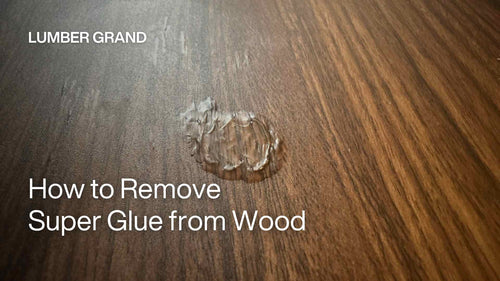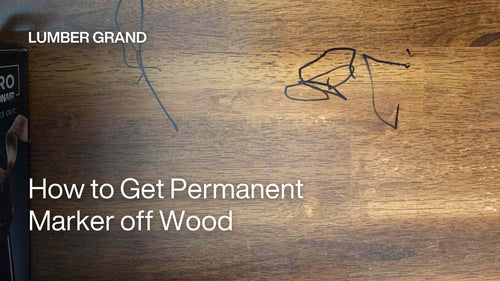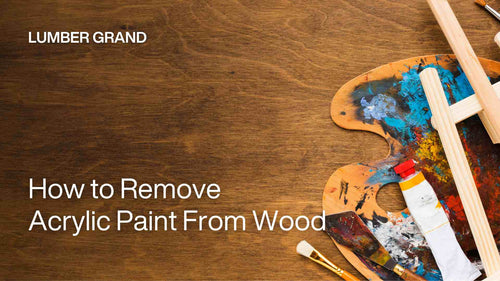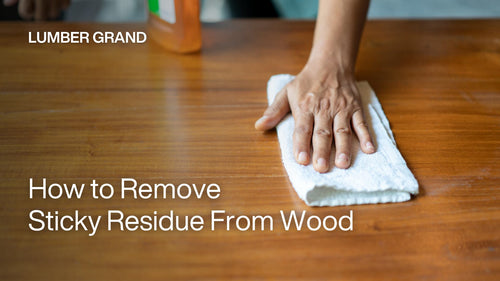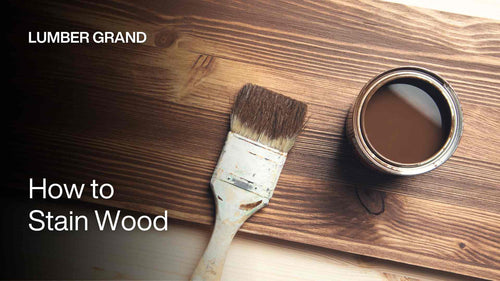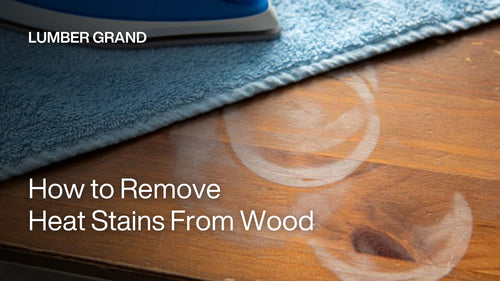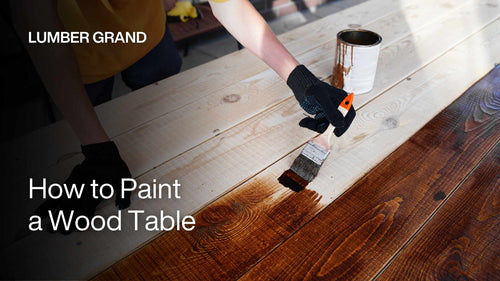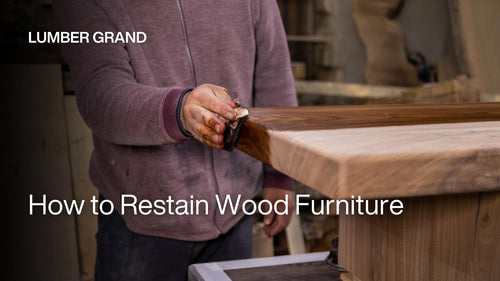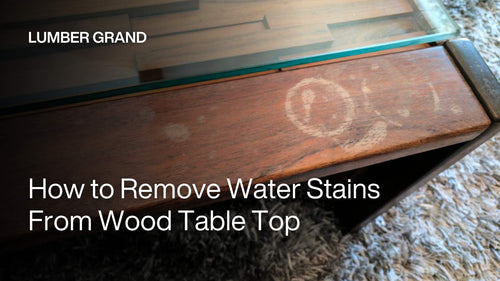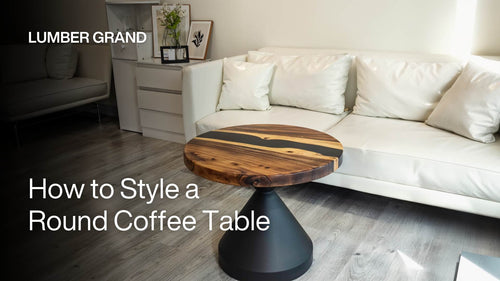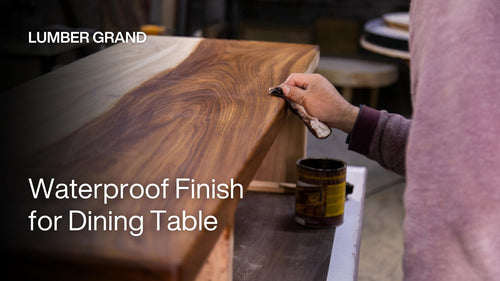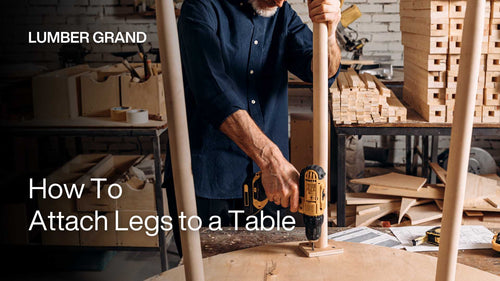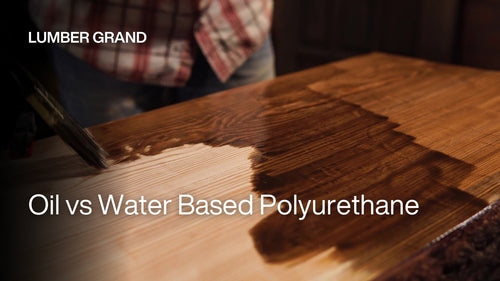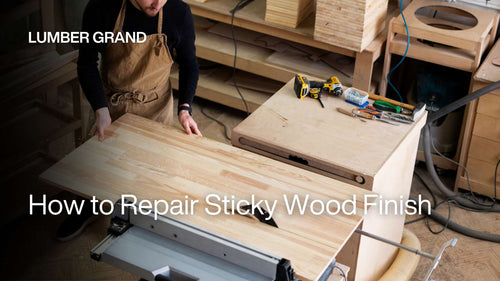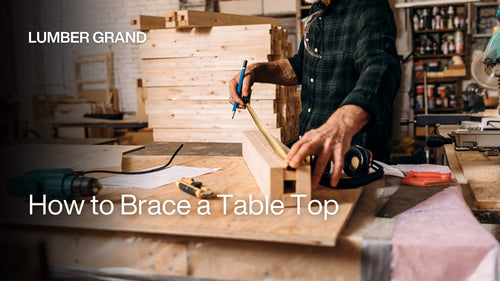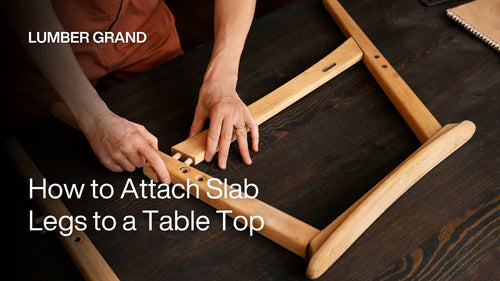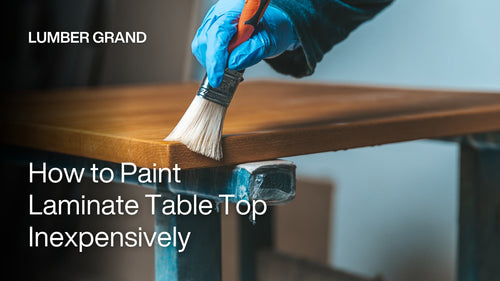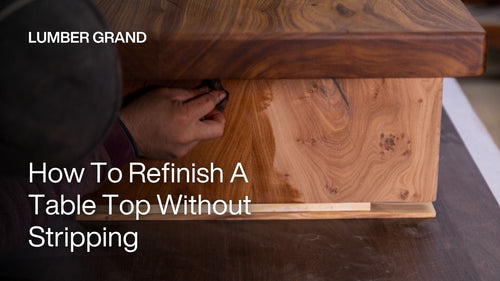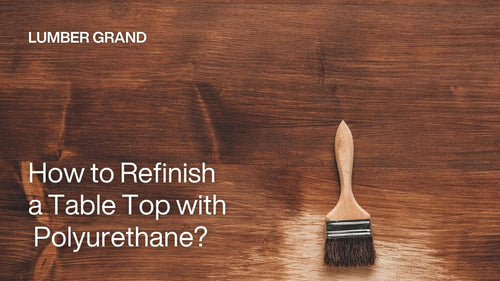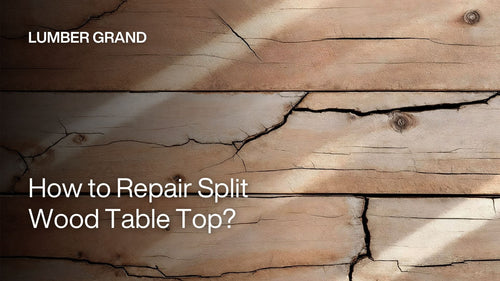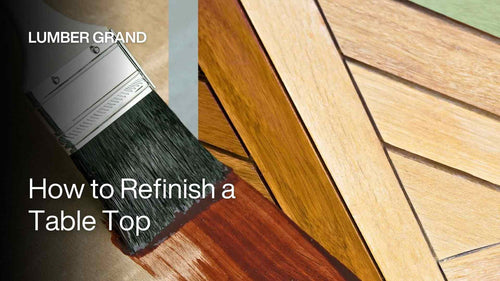How to remove paint from wood can feel like a daunting task, especially when dealing with old, stubborn layers. Old furniture, doors, or wooden trim can quickly lose charm under peeling paint.
The good news? With the proper home remedies to remove paint from wood, you don’t need to be a pro to get professional-looking results. Lumber Grand guides you through 5 easy methods that combine safety, efficiency, and DIY-friendly approaches. By the end, you’ll have the skills and confidence to strip away old paint and reveal gorgeous, ready-to-finish wood surfaces.
Why You Should Remove Paint
It's important to know why you should remove paint from wood before learning how to do it. Removing paint correctly can restore old furniture, protect the wood underneath, as well as offer the best possible finish surface. Here’s why people do it:
-
Repair and refresh: Old paint can retain moisture and eventually cause the wood to warp or crack. So you can remove it to restore the wood effectively.
-
Prepare for finishing: It also allows the new paint, oil, or stain to adhere better for an extended period.
-
Ensure safety: Above all, old paint removal helps ensure health safety since many old paints (especially those before 1978) have lead.
Lead Paint Safety Warning
Before starting any paint removal project, you MUST test for lead paint if your furniture or home was built before 1978, where lead paint is common [1] . There are 2 ways to test lead:
-
Home lead test kits: You can use the tool in the test kit to rub or swipe on đưa the surface. Usually, pink or red means the amount of lead exceeds the allowable limit. It’s speedy and straightforward, but only detects lead on the surface, not paint layers below.
-
Laboratory testing: You may need to provide the paint sample to the lab. It will typically be more accurate but will also take more time.
*If you find lead in the paint, stop and consider hiring a professional for maximum safety. If not, move to the next step.

Old furniture before 1978 may contain lead in paint
Credit: U.S. Environmental Protection Agency
Preparation Before Removing Paint
Next, examine the type of wood to choose the proper paint stripping method.
-
Softwoods like pine or fir will be more prone to scratching or denting
-
Hardwoods like oak, maple, or walnut can withstand more intrusive measures.
-
As for veneer furniture, you must be very gentle because the veneer layer is very thin.
Get your tools together first: Gloves, safety goggles, and a good mask like N95 or better. You'll also need a scraper, putty knife, and whatever paint removal product you choose. Clean the surface well before you start. Dust and grime interfere with how the remover works.

How to remove paint from wood without damaging the wood
Photo: Freepik
Related article: How to Paint a Wood Table
How to Remove Paint from Wood Furniture: 5 Methods from Easy to Hard Levels
Here are five highly effective ways to remove old paint without waiting any longer. Lumber Grand will guide you on how to use each method.
1. Apply Chemical Paint Stripper (Use with Caution)
A highly effective yet popular technique for removing paint is using a paint stripper. This solvent softens the old paint and makes it easy to scrape off. You only require the paint stripper for wood and a paint scraper (or putty knife) to remove the softened paint.
There are two main types of paint strippers: solvent-based and caustic-based. Lumber Grand has compiled a detailed comparison chart below to help you choose the best fit.
|
Type |
Effectiveness |
Impact on Wood |
Safety |
Best For |
|
Solvent-Based |
Very effective, fast |
Minor damage to wood grain |
Toxic fumes, use with ventilation |
Fine furniture, a carved or detailed wood piece |
|
Caustic-Based |
Very strong on thick oil paint |
Can discolor or damage wood |
Highly caustic, must be neutralized |
Multiple oil paint layers, projects with less aesthetic concern |
Simply follow these steps with us:
-
Step 1: Wear protective gear such as gloves, N95 masks, and goggles first
-
Step 2: Apply a thick, even coat of paint stripper to the painted wood surface. You can use a brush to apply to small or hard-to-reach areas.
-
Step 3: Let the stripper work according to the instructions. It's usually 15 — 30 minutes, depending on the product.
-
Step 4: Scrape as paint starts to bubble or lift. Push the softened paint off the wood using a scraper or putty knife
-
Step 5: Apply stripper to resistant areas, wait, and scrape again
-
Step 6: Wipe wood with a damp, clean cloth to remove residue, and let it dry completely
Note:
-
Always use in a well-ventilated area and with protective gear
-
Some strippers may discolor or damage some types of wood, so test first on a small, hidden spot.
-
Let the strippers fully soften the paint before scraping. Rushing this step can damage your wood table top or furniture.

How to remove paint from wood without sanding
Photo: Furniture Flipping For Profit
2. Sanding (Safest Method)
Sanding paint off wood is the most traditional and safest method. It works best for solid, sturdy wood surfaces once you've confirmed there's no lead paint involved.
We'll need sandpaper in different grits, which begin with coarse (80 — 120), move to medium (150), then finish with fine (220). Also, a power sander speeds things up considerably, though you can do it by hand if needed. Always wear an N95 mask. Sanding creates a lot of dust, you know.
Here’s a simple way to get it done:
-
Step 1: Begin by employing coarse-grit sandpaper (80 — 120) or using a power sander to eliminate the bulk of the paint
-
Step 2: Once the majority of the paint is gone, change to 150-grit sandpaper to remove any remaining residue and smooth out deep scratches left by the coarse grit
-
Step 3: Finish with fine 220-grit sandpaper to complete the smoothing of the surface
-
Step 4: Lastly, clean the whole surface using a fresh tack cloth to eliminate all the dust
Note:
-
Apply a moderate force, enough for the paint to strip off without harming the wood surface
-
For a smooth finish, always sand according to the grain of the wood
-
Not suitable for veneer or delicate carved details

How to strip paint from wood furniture with sanding
Photo: Freepik
3. Use a Heat Gun (Highest Risk)
The 3rd method to remove pain is to use a heat gun. The heat from a heat gun softens old paint much faster than a paint stripper, and allows you to scrape it off easily.
However, you’ll need to consider carefully before choosing how to remove paint from wood table, because it also involves some danger. If you don’t manage the temperature appropriately, you may end up ruining the wood surface or even burning the wood.
Here’s how to do it:
-
Step 1: Turn on and set the temperature to about 600 — 800°F
-
Step 2: Hold the heat gun about 2 — 3 inches from the wooden surface. Shake back and forth over a small section to loosen up the paint
-
Step 3: Once the paint peels or bubbles, you must prepare a scraper or putty knife to scrape it away.
-
Step 4: Hold the scraper in your other hand and gently push the softened paint off the wood surface. Avoid pressing too hard to avoid scratching the wood inside
-
Step 5: Continue doing the same with other areas, heating the heat gun, and scraping it off
-
Step 6: After removing most of the paint, wipe it clean with a damp cloth and let it dry completely
Note:
-
Wear heat-resistant gloves if you don't want to burn your hands before the paint cracks off
-
Heat can ruin paint, wood, or any other material near it, so take precautions and keep a safe distance.
-
Stop at once if you see the paint smoking.
-
Heat guns get up to 800 — 1100°F, and lead paint will emit poisonous dust at 900°F. Therefore, test for lead and carefully consider before opting for this process.

How to remove paint from wood table with a heat gun
Photo: Freepik
You might like: How to Refinish a Table Top
4. Use an Infrared Paint Striper (Moderate Safety)
An infrared paint stripper uses infrared rays to soften paint without excessive heat. So, no wonder it's safer than a traditional heat gun. The tool heats surfaces to approximately 400 — 600°F, and this is well below the danger zone for lead. That's significantly cooler than heat guns but still hot enough to require caution.
The advantage is reduced wood-burning risk and producing less smoke or dust than heat guns. We think this is a relatively safer option for lead paint compared to heat guns or sanders.
Still, proper ventilation and protective equipment are essential.
-
Step 1: Turn on the infrared unit and let it heat up according to the manufacturer's instructions
-
Step 2: Hold the device 2 — 3 inches from the surface and let the infrared rays soak through and melt the paint
-
Step 3: Let the device heat the paint for 10 — 15 seconds. You can see the paint bubble or loosen.
-
Step 4: Remove the loosened paint with a scraper
-
Step 5: Do the same with any other painted pieces and then wipe the top of the table with a gentle, wet cloth.
Note:
-
Work in small areas so you have more control
-
This method can release lead fumes, so make sure the table is lead-free, wear appropriate protective gear, and work in a well-ventilated area

How to remove paint from wood floor with an infrared device
Photo: North River Builders Inc
5. Use a Steam Stripper (Safest Chemical-Free Method)
A steam stripper offers a chemical-free way to remove paint. No smoke, no toxic fumes. The steam penetrates under old paint and lifts it effectively.
More so, it's one of the safer approaches for lead-based paint if you use proper ventilation and protective gear. Yet, calling in professionals for the lead is still an important choice.
However, the steam stripper comes with one drawback. It introduces moisture into the wood, which can cause warping, swelling, or delamination in veneered or laminated pieces. Avoid using it on antique furniture or pieces with veneer.
You’ll need a steam stripper, and let's go step by step:
-
Step 1: Turn on the steam stripper, fill it with water, and let it heat up as described in the manual
-
Step 2: Put the steam plate about 1 inch away from the painted surface for 30 — 60 seconds until the paint bubbles or curls
-
Step 3: Gently remove the loose paint using a scarper or putty knife
-
Step 4: Move on to the next spot, steaming and scraping after loosening paint
Note:
-
To minimize moisture absorption, you can dry-wipe the surface with a cloth directly after scraping.
-
Work in good ventilation to speed up wood drying

How to remove paint from wood furniture with steam
Photo: HouseBarons
Read more: Best Finish for Dining Table
After Paint Removal: 5 Tips for Finishing Touches
Once the old paint has been removed, it’s time to give your wood some care before you put a new finish on it. Reserve these 5 helpful tips on preparing the wood surface to perfection.
-
Clean with denatured alcohol or mineral spirits: Wipe the wood surface gently with the denatured alcohol or mineral spirits. It removes loose dust or grease so the wood has no residue before finishing.
-
Fix scratches or cracks: Fill with some wood filler for deep scratches or cracks. Let it dry completely before priming it using an electric sander.
-
Smooth it with 220-grit sandpaper: Before you paint or finish it, lightly sand the whole surface using 220-grit sandpaper. It makes the wood smooth, so the finish adheres best.
-
Test your finish first: Don't race ahead to paint or use the clear coat on the entire surface. Use it on an unnoticed area first, just as a test run for the color, luster, and adhesion. Then you won't face any unforeseen surprises before finishing the piece.
-
Seal and protect: When the surface is just right, complete by using a sealer. Polyurethane, varnish, oil, or wax could come in use. It's the last measure for shielding the wood from humidity, dust, wear, and tear, as well as preserving its looks in the long term.

Removing old paint will allow you to have more beautiful finish options
Credit: Lumber Grand
Shop now: Square Epoxy Coffee Table 35" x 35"
*Important Safety Disclaimer
This paint removal guide is for informational purposes only. Removing old paint can be risky, especially if there's lead paint involved. If you find lead paint when you test your table, then you should seriously consider getting a professional to safely handle it. Your health comes before saving a few dollars on this job.
The process creates a risk of toxic dust, fumes, and high temperatures, which can cause burns or damage to the surface. The operator should wear full protective gear (gloves, goggles, dust mask) and work in a well-ventilated area. Not recommended for inexperienced personnel.
FAQs
1. What is the Easiest Way to Remove Paint from Wood?
The easiest way to remove paint from wood depends on the surface or project you are working on. Sanding is the simplest and safest method for non-lead paint on flat surfaces. A chemical stripper is suitable for intricate details. An infrared paint stripper is an excellent choice for large areas when you want to avoid chemicals.
2. How Do You Get Dried Paint Off Hardwood?
If you have a dried paint stain on hardwood, we recommend using a specialized paint thinner or removal product. You can find these at hardware stores. The process is simple: apply the solution to the paint surface, wait for about 15 – 30 minutes until the paint bubbles, and scrape it off.
3. Does Vinegar Remove Paint from Wood?
No, vinegar doesn't work for removing cured paint from wood. You'll see this suggestion online, but vinegar lacks the chemical strength to break down dried paint layers. It might slightly soften very fresh latex paint, or emphasize very fresh, but it won't remove aged or dried paint effectively.
We advise using reliable methods like sanding, steam, infrared devices, or chemical strippers.
4. Does Rubbing Alcohol Remove Paint from Wood?
Yes, rubbing alcohol can remove fresh latex or acrylic paint, but it's not effective on dried or cured paint. You can use a cloth soaked in diluted alcohol and dab it on the stain, leave it for about 5 minutes, and scrape it off when the paint has softened.
However, alcohol cannot remove oil-based paint rôor special coatings. We recommend using stronger methods in our guide.
How to Remove Paint from Wood: Guide Ends Here
So, now you know the different ways to remove paint from wood. Always test for lead first if your piece was made before 1978. We’ll also break down each method's safety level and key notes to give you a more straightforward overview. [2]
|
Method |
Safety Level |
Notes |
|
Sanding |
Safest (if no lead present) |
Produces only dust, no chemicals or high heat Use N95 mask NOT safe for lead paint |
|
Steam Stripper |
Safest (chemical-free) |
No smoke or dust, low heat It can cause wood swelling. You should avoid it on the veneer. |
|
Infrared Device |
Moderate safety |
Lower heat than heat guns (400 – 600°F), less smoke/dust But it is bulky and hard to use in tight corners. |
|
Paint Stripper (Chemical) |
Use with caution |
Strong chemicals that can irritate skin, eyes, and lungs |
|
Heat Gun |
High risk (NOT recommended for beginners) |
Extreme heat (800 – 1100°F) can vaporize lead paint, burn wood, and cause fires. |
With these methods and tips on how to remove paint from wood, safety is no longer something you have to worry about. Now your wooden piece is ready for a fresh coat of paint or a brand-new finish. If you’d like more handy DIY tips, don’t forget to check out our blogs. Good luck and happy DIY-ing!









